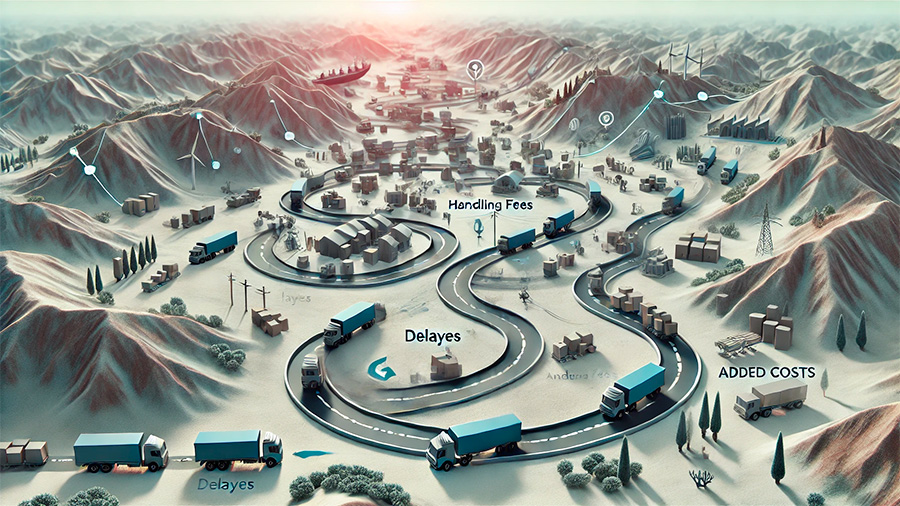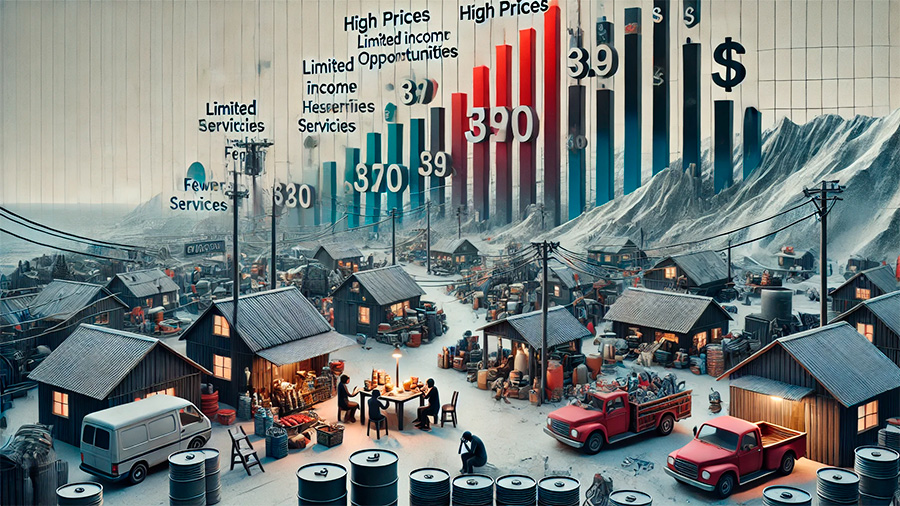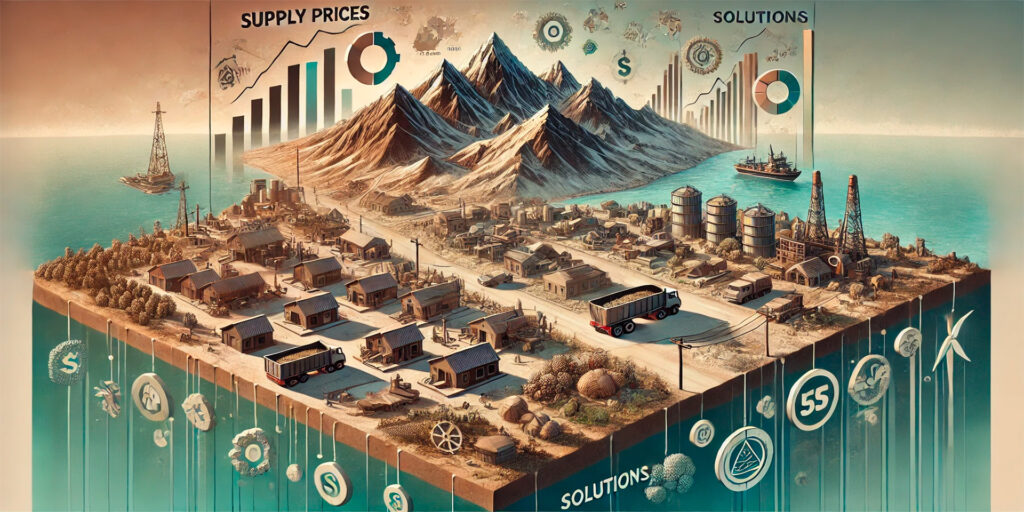Geographical isolation significantly affects the cost of goods in remote areas, primarily due to the distance from major transportation hubs and logistical challenges. Remote economies face higher prices for essential goods and services because of increased transportation costs, limited infrastructure, and supply chain complexities. As businesses in these areas struggle to meet demand while managing higher overhead costs, the economic burden is often passed on to consumers in the form of higher prices. Understanding how geographical isolation impacts the cost of goods is crucial for addressing economic disparities between urban centers and remote regions.
This article examines why remote areas face higher prices, the logistical challenges involved, and how geographical isolation shapes the economic realities for these communities.
Understanding the Relationship Between Geographical Isolation and Pricing
Geographical isolation directly impacts pricing in remote areas because it increases the cost of transporting goods from suppliers to end consumers. When goods must travel long distances from manufacturing plants, distribution centers, or import ports, the added transportation expenses quickly add up. Furthermore, the lack of well-developed infrastructure in these areas complicates the supply chain, requiring additional resources and logistical planning.
1. Increased Transportation Costs
Transportation costs are one of the most significant factors driving up prices in geographically isolated regions. Whether goods are delivered by land, air, or sea, the longer the distance they need to travel, the more expensive the process becomes. Fuel costs, driver wages, and maintenance fees all increase when transporting goods to remote locations, and these expenses are typically passed on to consumers.
Key factors contributing to high transportation costs:
- Fuel expenses: The further goods need to be transported, the higher the fuel consumption, especially when traveling over difficult terrain or across vast distances.
- Increased labor costs: Longer travel times require more labor hours, leading to higher wages and compensation for delivery personnel.
2. Limited Transportation Infrastructure
Many remote areas lack the necessary infrastructure, such as paved roads, railways, or airports, to efficiently transport goods. Poor infrastructure can slow down delivery times, further increasing costs. In some cases, specialized vehicles may be required to navigate rugged or inaccessible terrain, adding to the logistical complexity. This limitation in transportation networks increases the cost of moving goods to isolated regions, impacting the final price paid by consumers.
How infrastructure limitations affect prices:
- Longer delivery times: Poor roads and limited access routes can delay shipments, increasing the overall cost of getting goods to market.
- Specialized transportation: In areas with difficult terrain, goods may need to be transported using off-road vehicles, helicopters, or boats, which adds to operational costs.

Supply Chain Complexities in Remote Economies
In addition to transportation challenges, supply chain complexities play a significant role in driving up costs in remote economies. In isolated regions, goods often pass through multiple distribution points before reaching their final destination, adding to the overall cost. This extended supply chain increases the chances of delays, additional handling fees, and higher prices for consumers. Moreover, remote areas typically face limited access to bulk purchasing, which can lead to higher per-unit costs.
1. Multi-Tiered Supply Chains
Remote economies often rely on multi-tiered supply chains that involve multiple stops before goods reach the final consumers. For example, goods may need to be transported from a central distribution hub to a regional depot and then to the remote community. Each stage of this process adds extra handling, storage, and transportation fees, which ultimately increase the price consumers pay.
How multi-tiered supply chains increase costs:
- Additional handling fees: Each time goods are transferred between points in the supply chain, handling and storage costs are added to the final price.
- Increased risk of delays: Multiple transfer points increase the potential for logistical bottlenecks, which can further raise costs due to missed delivery windows.
2. Smaller Market Demand and Economies of Scale
One of the challenges faced by businesses operating in remote areas is the lack of economies of scale. In smaller, more isolated markets, there is typically lower demand for goods, which means businesses cannot order or produce in large quantities. Bulk purchasing is often not feasible, leading to higher per-unit costs for goods. These higher costs are then passed on to consumers, making even everyday items more expensive in remote areas.
How limited demand impacts pricing:
- Higher per-unit costs: Small businesses in remote areas face higher per-unit prices when ordering smaller quantities of goods, leading to increased retail prices.
- Lack of competition: In many remote areas, fewer businesses operate, which reduces competition and allows prices to remain high.
The Role of Seasonal and Weather-Related Factors
In many remote regions, seasonal and weather-related factors further complicate the transportation and supply chain process, leading to price fluctuations throughout the year. Harsh weather conditions, such as heavy snow, rain, or extreme temperatures, can make transportation more difficult and expensive, especially when access routes become impassable. This seasonal unpredictability increases costs for businesses, which may need to stockpile goods or delay shipments, driving up prices for consumers.
1. Seasonal Shipping Challenges
In regions with extreme climates, the ability to transport goods can be limited during certain seasons. For example, roads may become inaccessible due to snow in winter, or shipping by sea may be delayed during stormy seasons. As a result, businesses may have to stockpile goods in advance to meet consumer demand during these periods, leading to increased storage costs and higher prices.
Examples of seasonal shipping challenges:
- Winter weather disruptions: Heavy snowfall or icy roads can make it impossible to deliver goods during winter months, forcing businesses to pre-order supplies, which raises costs.
- Monsoon or hurricane seasons: Coastal and island communities may face transportation delays during storm seasons, increasing the cost of goods as supply chains are interrupted.
2. Stockpiling and Price Volatility
Due to the unpredictable nature of weather conditions in remote areas, businesses often need to stockpile goods to ensure they have enough inventory during periods when transportation is disrupted. While stockpiling helps prevent shortages, it also leads to additional costs, such as storage fees, inventory management, and the risk of spoilage for perishable items. This, in turn, drives up prices for consumers, particularly during peak demand periods.
How stockpiling affects consumer prices:
- Increased storage costs: Businesses must pay for storage facilities to hold goods during times when transportation is not feasible, and these costs are passed on to consumers.
- Price volatility: The need to stockpile during certain seasons can lead to sharp fluctuations in prices, particularly for goods that have a limited shelf life or are difficult to store.

Consequences of High Prices for Remote Communities
The higher cost of goods in remote areas has a significant impact on the quality of life for residents. For many, the increased cost of basic necessities such as food, fuel, and household items can strain already limited household budgets. This economic burden exacerbates inequalities between urban and remote areas, as residents in isolated regions often have fewer income opportunities and face higher living expenses. Furthermore, high prices can limit access to essential goods, services, and healthcare in these communities.
1. Strain on Household Budgets
In remote areas, the higher cost of everyday goods can place a considerable financial burden on households, particularly those with lower incomes. Families may need to allocate a larger portion of their income to cover the cost of essentials, leaving less disposable income for other expenses such as education, healthcare, or savings. Over time, this can widen the economic gap between urban and rural populations, contributing to persistent poverty in remote regions.
Impact of high prices on household budgets:
- Reduced purchasing power: Households in remote areas face higher prices for basic necessities, limiting their ability to save or invest in their future.
- Economic inequality: The higher cost of living in remote regions exacerbates disparities in income and wealth between rural and urban populations.
2. Limited Access to Goods and Services
In some cases, the higher cost of transporting goods to remote areas can lead to limited availability of certain products or services. For example, fresh produce, healthcare supplies, and specialized goods may be difficult to obtain due to high transportation costs. This limited access can affect the overall health and well-being of residents, particularly in communities that rely on imported goods for their livelihoods.
Consequences of limited access:
- Food insecurity: High transportation costs for perishable goods such as fruits and vegetables can lead to limited availability, resulting in food insecurity in remote areas.
- Restricted healthcare access: The high cost of transporting medical supplies or the limited availability of healthcare providers in remote areas can reduce access to essential healthcare services.
Conclusion
Geographical isolation has a profound effect on the cost of goods in remote areas, driven by increased transportation expenses, logistical challenges, and supply chain complexities. Residents in these areas face higher prices for basic necessities, which can strain household budgets and limit access to essential goods and services. Addressing these economic disparities requires innovative solutions, such as improving infrastructure, investing in alternative transportation methods, and supporting local businesses to reduce costs and ensure access to affordable goods for remote communities.


